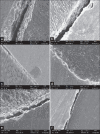Effect of different root canal irrigants on the sealing ability of two all-in-one self-etch adhesives: An in vitro study
- PMID: 23112488
- PMCID: PMC3482754
- DOI: 10.4103/0972-0707.101917
Effect of different root canal irrigants on the sealing ability of two all-in-one self-etch adhesives: An in vitro study
Abstract
Aim: To evaluate the effect of different root canal irrigants on the sealing ability of two self-etch adhesives, using dye penetration method, within the pulp chamber.
Materials and methods: 72 extracted human molars were divided into six groups, according to the irrigant and self-etch adhesives used. After de-roofing the pulp chamber with a carborundum disc, the pulp was extirpated using excavator and broaches. In 36 samples, pulp chambers were bonded with Xeno V after irrigation with either 2% CHX (Group1: Xe-CHX) ; 17% EDTA + 5.25% NaOCl (Group2: Xe- EDTA + NaOCl) or normal saline (Group3: Xe-NS) and in other half samples, pulp chambers were bonded with Adper Easy One after irrigation with either 2% CHX (Group 4: Ad-CHX); 17%EDTA + 5.25% NaOCl (Group5: Ad-EDTA+NaOCl) or normal saline (Group 6: Ad-NS). All the samples were restored with Filtek Z350. Ten teeth from each group were assessed for dye penetration. Two samples in each group were viewed under scanning electron microscope to observe resin-dentin interfacial adaptation. Data was statistically analyzed using Mann-Whitney and Kruskal Wallis tests at a significance level of P < 0.05.
Results: MEAN MICROLEAKAGE SCORES AND STANDARD DEVIATION OBSERVED WERE: Group 1 (Xe-CHX): 2.8 ± 0.42, Group 2 (Xe-EDTA + NaOCl): 2.3 ± 0.82, Group 3 (Xe-NS): 2.9 ± 0.31, Group 4 (Ad-CHX): 1.2 ± 0.91, Group 5 (Ad-EDTA + NaOCl): 0.8 ± 0.63, Group 6 (Ad-NS): 1.9 ± 0.99.
Conclusions: Adper Easy One showed significantly less leakage than Xeno V when normal saline was used as an irrigant. EDTA treatment followed by NaOCl application significantly reduced microleakage and improved the interfacial adaptation with Adper Easy One. CHX did not significantly affect the sealing ability of both one-step self-etch adhesives tested.
Keywords: Dye penetration; pulp chamber dentin; root canal irrigants; sealing ability; self-etch adhesives.
Conflict of interest statement
Figures

Similar articles
-
Effect of Qmix and Other Irrigants on Dentin Adhesives in Pulp Chambers of Primary Teeth: SEM Study.J Clin Pediatr Dent. 2017;41(5):363-367. doi: 10.17796/1053-4628-41.5.363. J Clin Pediatr Dent. 2017. PMID: 28872986
-
Effect of proanthocyanidin treatment on the bonding effectiveness of adhesive restorations in pulp chamber.J Clin Pediatr Dent. 2013 Fall;38(1):49-53. doi: 10.17796/jcpd.38.1.j830501558510792. J Clin Pediatr Dent. 2013. PMID: 24579283
-
Adhesive bonding to pulp chamber dentin after different irrigation regimens.J Investig Clin Dent. 2015 Nov;6(4):287-93. doi: 10.1111/jicd.12107. Epub 2014 Jul 17. J Investig Clin Dent. 2015. PMID: 25045168
-
Ex vivo evaluation of dye penetration associated with various dentine bonding agents in conjunction with different irrigation solutions used within the pulp chamber.Int Endod J. 2008 Nov;41(11):950-7. doi: 10.1111/j.1365-2591.2008.01456.x. Int Endod J. 2008. PMID: 19133084 Clinical Trial.
-
An in-vitro assessment of the irrigants and irrigation protocols effect on the ProRoot MTA marginal leakage in the furcal perforations.Sci Rep. 2025 Feb 21;15(1):6319. doi: 10.1038/s41598-025-90841-3. Sci Rep. 2025. PMID: 39984576 Free PMC article.
Cited by
-
The effects of chlorhexidine and ethanol on push-out bond strength of fiber posts.J Conserv Dent. 2016 Jan-Feb;19(1):96-100. doi: 10.4103/0972-0707.173210. J Conserv Dent. 2016. PMID: 26957803 Free PMC article.
-
A Comparative Evaluation of Sealing Ability of New MTA Based Sealers with Conventional Resin Based Sealer: An In-vitro Study.J Clin Diagn Res. 2016 Jul;10(7):ZC76-9. doi: 10.7860/JCDR/2016/18909.8194. Epub 2016 Jul 1. J Clin Diagn Res. 2016. PMID: 27630959 Free PMC article.
-
An in vitro evaluation of the effect of dentin deproteinization on coronal microleakage in endodontically treated teeth.J Int Soc Prev Community Dent. 2014 Dec;4(Suppl 3):S187-92. doi: 10.4103/2231-0762.149036. J Int Soc Prev Community Dent. 2014. PMID: 25625077 Free PMC article.
-
Bonding efficacy of etch-and-rinse adhesives after dentin biomodification using ethanol saturation and collagen cross-linker pretreatment.J Conserv Dent. 2015 Jul-Aug;18(4):331-6. doi: 10.4103/0972-0707.159751. J Conserv Dent. 2015. PMID: 26180421 Free PMC article.
-
Comparison of the apical seal obtained by Adseal, Proseal, and AH26 sealers in root canal obturation with lateral compaction technique.Dent Res J (Isfahan). 2023 Aug 28;20:94. eCollection 2023. Dent Res J (Isfahan). 2023. PMID: 37810455 Free PMC article.
References
-
- Ray HA, Trope M. Periapical status of endodontically treated teeth in relation to the technical quality of root filling and the coronal restoration. Int Endod J. 1995;28:12–8. - PubMed
-
- Swanson K, Madison S. An evaluation of coronal microleakage in endodontically treated teeth. Part I. Time periods. J Endod. 1987;13:56–9. - PubMed
-
- Magura ME, Kafrawy AH, Brown CE, Jr, Newton C. Human saliva coronal microleakage in obturated root canals: An in vitro study. J Endod. 1991;17:324–31. - PubMed
-
- Maruok R, Nikaido T, Ikeda M, Ishizuka T, Richard M, Foxton, et al. Coronal Leakage Inhibition in Endodontically Treated Teeth Using Resin-coating Technique. Dent Mater J. 2006;1:97–103. - PubMed
-
- Galavan RR, Jr, West LA, Leiwhr FR, Pashley DH. Coronal microleakage of five materials used to create an intracoronal seal in endodontically treated teeth. J Endod. 2002;28:59–61. - PubMed
LinkOut - more resources
Full Text Sources
Miscellaneous

